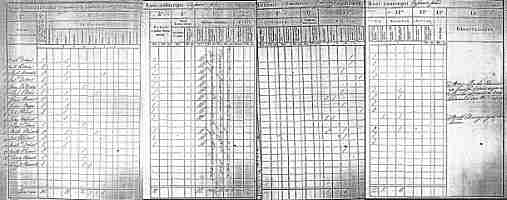Vasárasfalú is a small village just southeast of the town of Beled in Sopron county. Unlike Beled -- which had a considerable number of small property owners -- the Vasárasfalú farmland was primarily owned by large landholders. Since this census only applied to tax-paying property owners, there were very few properties to be enumerated in this village. In fact, you see all 17 of them on this census register, although the population of the village was in the hundreds. János Mátis, number 10 on this form, is one of my many relatives who lived in the Beled area. For several reasons, most researchers find the 1828 census to be of very limited value. See note below for further general information on this census.

Format: 14 Major Column Headings over a 4-page Folio.





Page 1 --- Page 2 --- Page 3 --- Page 4



Detailed Content of 1828 Census Records by Column or Block.
The top of the form provides the name of the jurisdiction (County of Sopron) and the village being enumerated (Vásárosfalú). The form is entirely in Latin. In the left margin a sequence number of the 17 taxpayers of the village is provided. My relative is János (Joan.) Mátics, taxpayer #10.
- Column 1 - Nomina Contribuentium. Name of principal person providing information for this property.
- Column 2 - Number of people providing information between 18 and 60 years of age of both sexes. Note that none is indicated for Taxpayer #10, column 14 will explain that.
- Block 3 -- Ex his sunt (of these are): categorizes the people on the property by status.

- Block 4 -- Domus a quibus Census solvitur. Number of houses and their value for this household. Note that 4 of the 5 subinquilini had no house and (see Block 6) had no land under cultivation, so their inclusion probably had to do with military service.
- Block 5 -- Fundi Intravillani. Size and value of urban fields (kitchen gardens).
- Block 6 -- Procreatio Seminaturae. Size and value of land under cultivation with grain.
- Block 7 -- Prata. Size and value of land used as meadows (ie. hayfields).
- Block 8 -- Vineae. Size and value of land used as vineyards.
- Block 9 -- Pomaria et Pruneta. Size and value of land used as apple and plum orchards.
- Block 10 -- Pecora. Number of large domestic animals (cattle and horses) of various types.
- Block 11 -- Pecudea. Number of small domestic animals (sheep, swine, and goats).
- Block 12 -- Sylvae. Size and value of land that is forested (woodlands).
- Block 13 -- Educillum. Signatures.
- Column 14 -- Observationes. Remarks. For taxpayer #10, it is noted that the farmer is over 60 years old (which was the case, he was born in 1761) and that is why he was not counted in column 2.